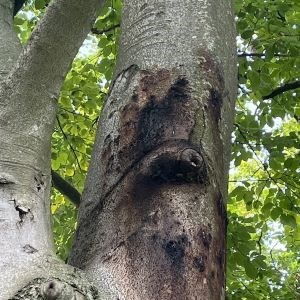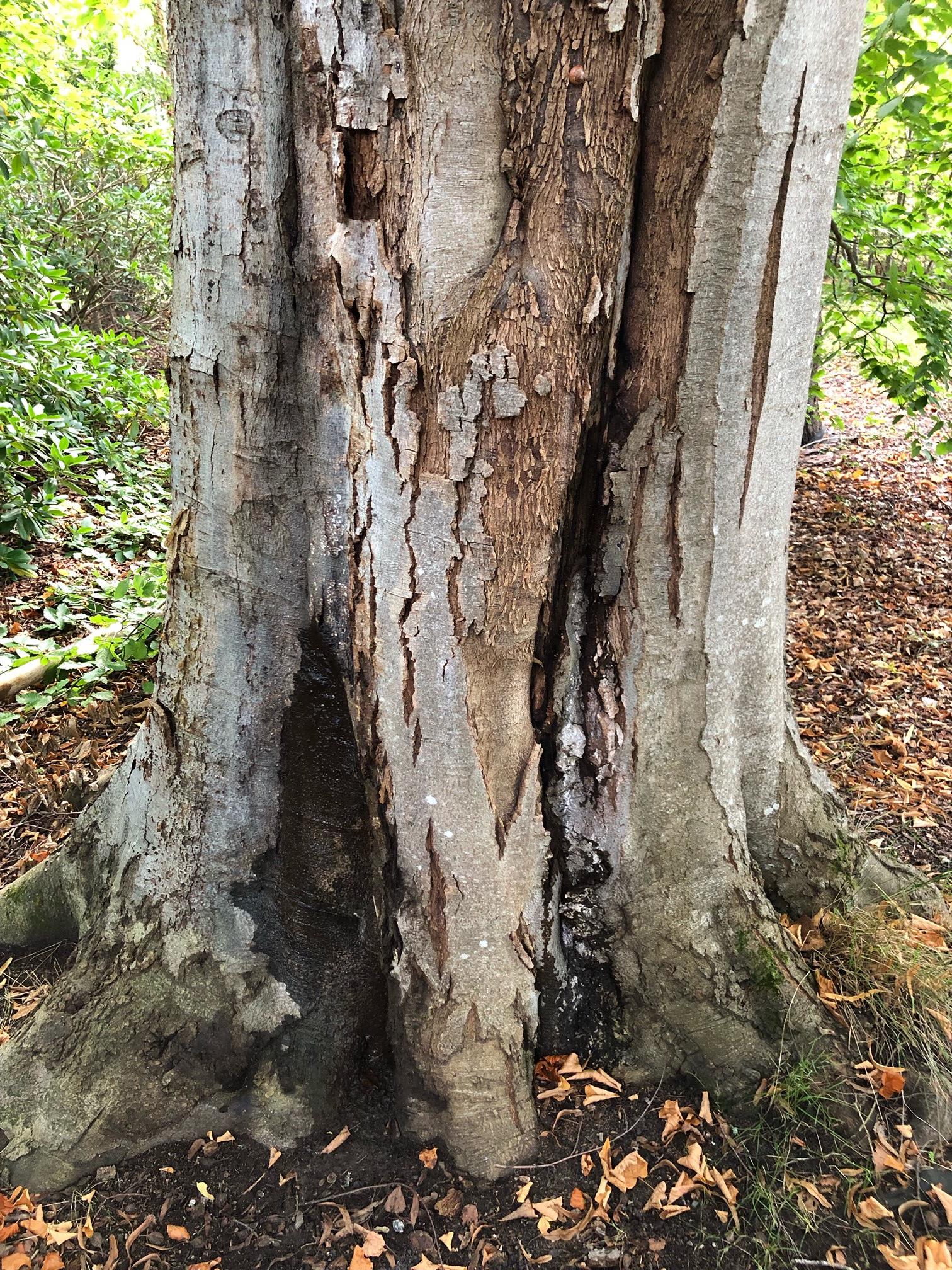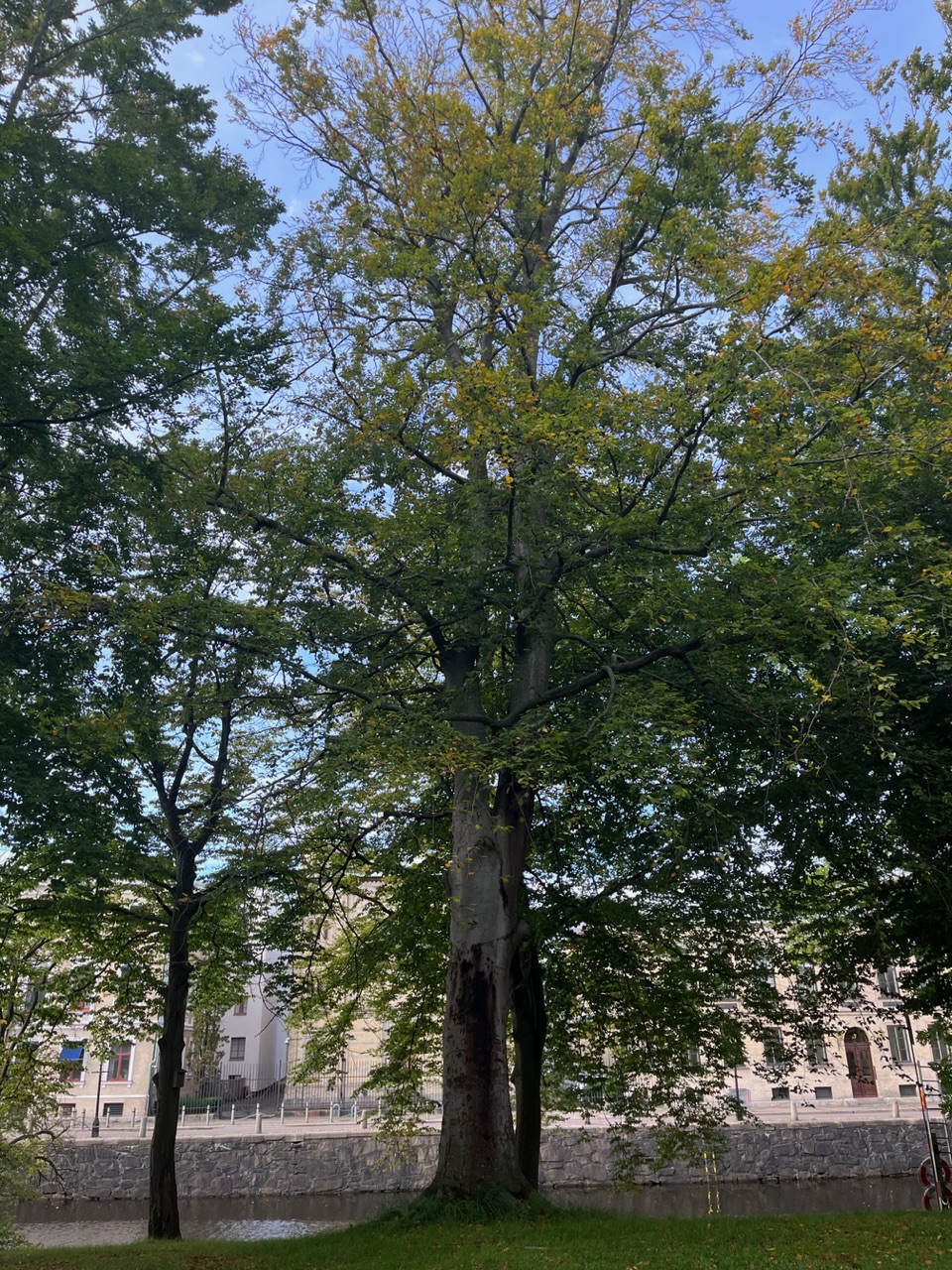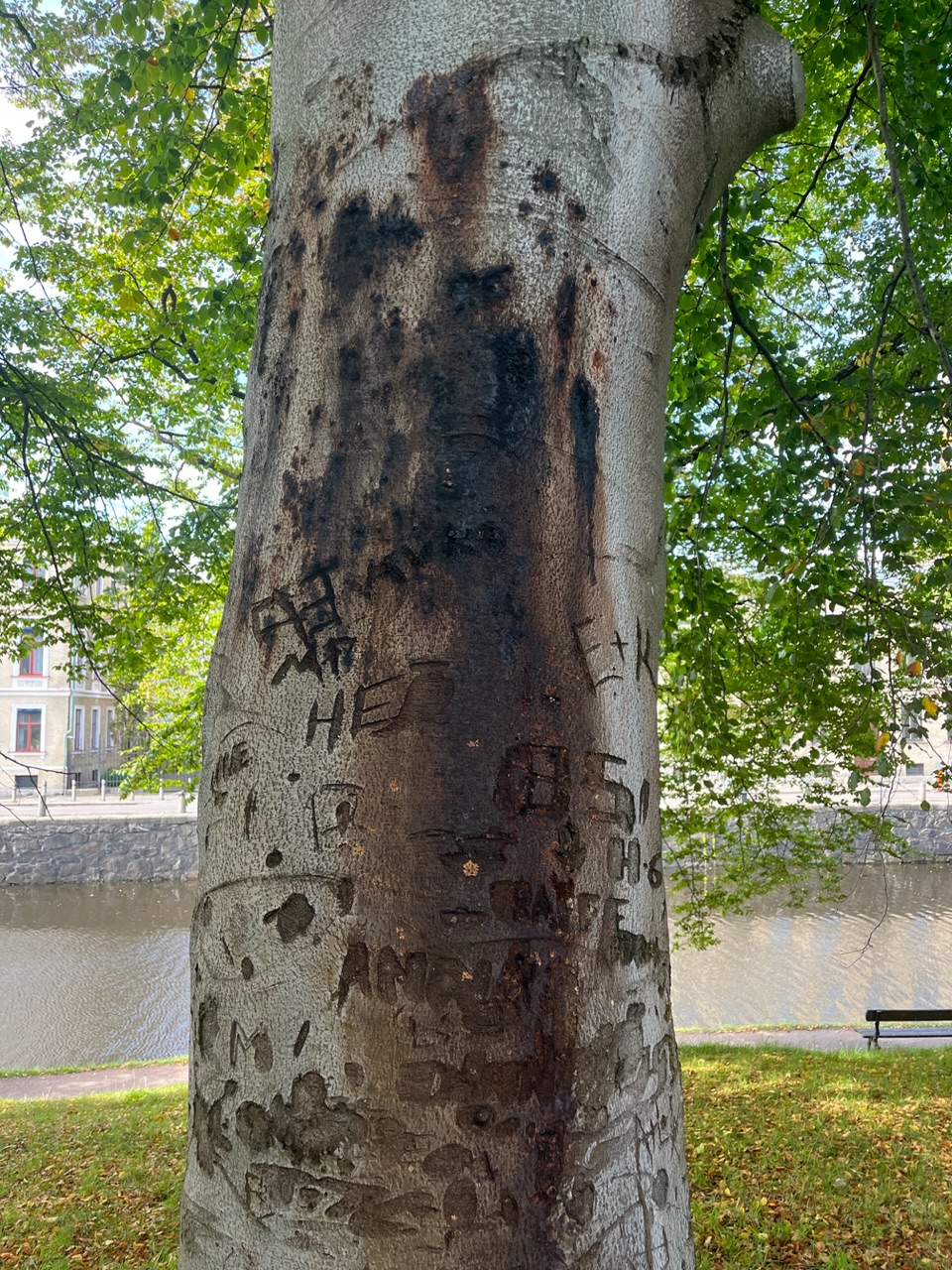Contact
audrius.menkis@slu.se, 018-672729
iryna.matsiakh@slu.se, +4640-41 53 94, 038-095-22 91 087

Species from the genus Phytophthora are predicted to cause increasing problems related to plant health in the future, also in Sweden. To protect us and our trading partners, up-to-date knowledge is needed regarding the species that has already been established in the country. The present status of Phytophthora in Sweden has now been described in a review article by Audrius Menkis and Iryna Matsiakh, analysts at the SLU Forest Damage Centre.
Among all microbial pests and pathogens, the genus Phytophthora are often considered the perhaps most serious threat to our future food production, forestry and plant trade. It’s already in the name: Phytophthora literally means “destroyer of plants”, and albeit there are species that adopt a purely saprophytic way of life, most of them are known to us because they attack plants. This can happen in every thinkable way – through roots or bark, in the crown or greenery, in fruits and buds, on everything from seedlings and yearly crops to fully grown trees. And there are many species. New ones are discovered every year, and whomever dares speak about their numbers better be well prepared. In an article from 1999, Clive Brasier says that there are 60. 20 years later, we knew of more than 180, mostly thanks to the revolution in molecular methods, and in an article from 2023 Audrius Menkis and Iryna Mastiakh mentions 326 described species. In 2009, Clive Brasier estimated there might be 500 still not discovered.
Actually, one of the issues with Phytophthora is that the number of species is not exactly constant. One of the more aggressive species, P. x alni, attacks alders and causes great destruction along riverbanks. This species is believed to be a hybrid that arose from a cross between other Phytophthora-species, among them P. cambivora. Most such hybrids turn out less adapted to survival than their parents and quickly disappear, but some inherit unique combinations of traits and find their own niches to fill. This ability to hybridize is one of the dangers associated with species from this genus.
Another is the genus’ enormous versatility. The species exists all over the world and thrive in temperatures from 10 to 30 °C, and excel at adapting to new environments. P. cactorum got its name when it was found on cacti in the 19th century, and thus can tolerate heat. But it has proven able to attack hundreds of species and has spread to Canada, Finland and Sweden. In Finland, it is causing disease on birch and growths at its best around 17 °C, and so has successfully adapted to the climate as well as to the hosts in its new home. These traits make Phytophthora species extra dangerous in light of the ongoing climate changes.
A wide host preference is not unique to P. cactorum. Some species do exhibit rather narrow specificity, such as the alder specialist P. x alni and P. quercina, which is exclusively targeting oak. But this genus also contains beasts such as P. cinnamomi, which appears to be able to attack just about anything. It is best known for its outbreaks on eucalyptus in Australia, but in just that country alone 2 284 hosts have been identified. According to Hardham and Blackman (2018), the list of susceptible hosts now covers almost 5 000 species. Besides Australia, the Mediterranean, Mexico and southern USA are severely affected. Luckily, P. cinnamomi is not as adaptable to temperature as P. cactorum and does not survive in sub-zero degrees, but as global warming progresses it will certainly become more common in hitherto inhospitable regions. In Sweden, it has so far only been found once, in the soil beneath a rhododendron plant in a green house in 2017. But that finding alone shows that it may come here, especially through trade, and southern Sweden is probably inhabitable already today.

Phytophtora infested beech in Uppsala. Photo: Audrius Menkis.
Phytophthora species have spread across the world in various ways, but the most important factor to stimulate spore production is water. Species like P. x alni and P. cinnamomi attack through the roots, and that is where their spores are produced. Phytophthora spores can swim, and once in the water they can seek out new host plants on their own. The journey is mostly random, but from a few centimeters range they can sense the presence of a susceptible root and swim up to it.
The force of the water itself is of course much more important for transport across larger distances, and spores washed out in waterways by rain water or flooding may spread far. Flooding may also expose trees in normally not Phytophthora-infected soil to spores. This happens regularly in California, where flooded walnut, cherry and apple orchards subsequently develop bleeding stem wounds. In some cased the pathogens found in the wounds are not the species usually present in the flooding rivers, which means that the excess water also releases spores from somewhere else and allows them to come in contact with the trees.
Water may cause problems even though there are no rivers to flood. In Texas 2019, a citrus orchard was hit by a powerful rainstorm. Sometime later, one half of the orchard was severely affected by root- and stem wounds. The healthy half were situated half a meter higher than the attacked one, and before the rains its water table stood one meter lower. Even though the amount of Phytophthora was equally large in both soils, the higher water table, lower altitude and less efficient drainage meant that one remained waterlogged for a longer time, and was much harder hit.
In a future of more extreme and static weather systems, flooding will become a more common phenomenon, which can be assumed to lead to more Phytophthora-related problems. In 2023, large parts of Sweden was hit by extensive and long-lasting floods. It is likely that spread of Phytophthora increased in the submerged areas. It would be interesting to study the presence of stem wounds and thinning crowns in these areas in the years to come to understand in what way flooding affects the behavior of Phytophthora in Sweden.
In spite of this, floods and waterways are probably not the most important reason Phytophthora are spreading across the globe. In his thesis from 2018, Miguel Angel Redondo state that the diversity of Phytophthora species is largest in nurseries, and larger in urban forests than in natural ones. In other words, the more human activity, the more species. In another study, 700 nurseries from 23 countries were investigated, and Phytophthora was found in 92 %. Trade in plant material, especially from nurseries, is a well-known risk. Since the spores are spread though water, it will probable suffice that one single plant is contaminated for the whole nursery to be attacked, once the irrigation flushes the spores through the soil. The nurseries sell the plants along with the soil they grow in, and may thus disperse the pathogen wide and far.
Contaminated soil may also stick to shoes, car tires and tools, and end up literally anywhere. That is why there is a strong correlation between the intensity of management, physical activity, and species richness. Many Phytophthora species that are present in Sweden today, but were not historically, arrived here mainly through nurseries, in second hand through accidently displaced soil. In this regard, it is a problem that not every Phytophthora host develop symptoms of disease. Such seemingly healthy hosts may produce spores, and thus still cause much devastation when planted.
It is assumed that trade will continue to spread disease. But the invasive species that has caused outbreaks were often not known as pathogenic before the outbreak took place. This goes for the Dutch elm disease, ash dieback and the emerald ash borer. If we know the potential pathogens present in a country, we are better posed to adjust trade with that country accordingly. For example, we know that the pine wood nematode is present in Portugal, and hence we can see to that all pine wood exported from Portugal must undergo heat treatment. Expensive, but better than spreading disease.

Phytophtora infested beech in Gothenburg. Photo: Mårten Lind.
A study from 2019 attempts to estimate the number of Phytophthora species that should exist in a large number of the world’s most important export countries. The estimation takes in account the over 12 000 Phytophthora outbreaks so far recorded, and considers the diversity of the country’s ecosystems and the way agriculture and forestry is conducted. This number is then compared to the number of reported Phytophthora species from each country. The authors suggest that if the difference is large, i.e. if the country has reported far less Phytophthoras than the model calculates that they should have, trade with that country constitutes a risk.
If it is the other way around, there are probably few unknown Phytophthoras present and whomever trading with the country know what species to account for. According to the study, China constitutes the greatest risk, since there could be 30-40 not yet discovered Phytophthora species. Next in line are India, Indonesia, Brazil, Russia and Türkiye. Australia makes for an opposite as the country that probably has done the most to describe its national flora of Phytophthoras.
Such work with regards to Sweden has been undertaken by Audrius Menkis and Iryna Matsiakh, analysts at the SLU Forest Damage Centre. They describe our current knowledge on Phytophthoras in woody plants in Nordic countries, what threat they pose in different environments, their origin, hos specificity, symptoms, introductory pathways and geographical range. They state that there is a risk for spread within and among adjacent countries, and that a higher awareness is needed regarding the dangers of importing plant material.
According to Menkis and Matsiakh, 17 Phytophthora species has been found in Sweden, in nurseries, cities, natural or managed forests, and waterways. Among these, nine were considered invasive, and among them six cause damage to woody plants. Here is a sample.
P.x alni, mentioned above, is widespread in European waters were alders exists. It was discovered in south-western Sweden in the 1990’s and had been imported by plant material to nurseries. Its most aggressive form has so far only been found in the southern part of the country. Cold winters has so far limited its spread, but climate change is expected to change this. There seems to be a very limited natural resistance to P. x alni in the alder population, which is why it is likely that the problems will increase in the future.
P.camivora also attacks the roots of the trees and commonly cause bleeding stem wounds. In Sweden it is present in nurseries, cities and natural forests, and is very virulent on beech, birch, linden, oak and aspen. The problems are worst on beech, but it has been found as far north as Oslo and does not seem very affected by cold weather. It is important to be vigilant in nurseries and with planted material to limit further spread.
P.cryptogea was discovered in Sweden in 2019, in among other places Christmas tree plantations. It is very aggressive on spruce in general and is predicted to cause large problems in the future, not only to Christmas trees but maybe to forestry as well. It thrives in 10-20 °C and seems well adapted to establish itself in most of the Swedish spruce range.
P.plurivora may, just like many other species, attack a wide variety of hosts. It is considered one of the most serious pathogens of the genus and has spread all over the world. It was found in Sweden in 2012 and in Malmö in 2016. It is one of the most common Phytophthora species in our forests and cities, and cause great damage to beech and oak. It may destabilize beech forests and other broadleaf-based ecosystems in southern Sweden.
P.quercina is strictly associated with various species of oak, and contributes to oak death in Sweden, especially in trees older than 100 years. The association is not very linear, however, and other factors, biotic or abiotic, are probably needed in order for the oaks to die.
P.ramorum, one of the most aggressive Phytophthora species, differ from many others by being able to spread through air. It is however still dependent on water, and is mostly dispersed in rain or extremely high humidity. It was found in Sweden in 2002 and is believed to have been imported through infected rhododendron plants via nurseries. If climate change leads to milder winters and more rainy springs, it could cause great devastation in Sweden, especially on beech and birch but also on many other species.
In the 1960’s, a devastating outbreak of P. cinnamomi took place among the eucalyptus of Australia, and since then the number of cases have grown exponentially. Most Swedish findings have been made in the 2000’s, primarily caused by pathogens hitch-hiking on plants imported for planting. A warmer, more humid, and more extreme climate is predicted to cause increasing problems with a number of Phytophthora species. Different models estimate a temperature increase in Sweden by 3-7 °C, and an increased summer precipitation by up to 40 %. This will benefit extremely serious pathogens such as P. x alni, P. cinnamomi, P. ramorum and P. plurivora.
Menkis and Matsiakh claim that the presence of aggressive Phytophthoras in especially southern Sweden already today must be seen as a serious threat. Ecologically important broadleaf trees such as beech, oak, ash, birch and elm are attacked increasingly often, and to reduce the damage we need updated knowledge on newly discovered species, and plans to manage those already known.
The best way to protect against Phytophthora species is not to move them in the first place. Once established they will remain for many years since spores and other resting structures are very long lived. To limit damage and further spread, directed management is needed, and Menkis and Matsiakh list a number of effective approaches. Organic waste should not be disposed in the vicinity of forests, urban gardens and parks, and all transport across infected areas minimized.
Tools and machinery used where disease is present should be disinfected, and if possible work should be done on frozen ground not to displace infected soil. Plant material from infected plants must not be used, and ditches and drainage may counter the problems of floods. Control agents can be important methods in nurseries. Species susceptible to attack may sometimes be replaced by more resistant alternatives: for example, spruce is less sensitive than fir and can be an option for Christmas tree plantations. Invasive species that could spread Phytophthoras along, such as killer slugs, should also be managed.
Fundamental knowledge of these principles in the entire plant growing business is a requirement to stop the spread of Phytophthora, in Sweden and in the rest of the world.
Text by Mårten Lind

Phytophtora infested beech in Gothenburg. Photo: Mårten Lind.
audrius.menkis@slu.se, 018-672729
iryna.matsiakh@slu.se, +4640-41 53 94, 038-095-22 91 087
Identification of Flooding Risk Factors in Texas Citrus Production with UAV imagery: A Case Study. Laughlin, 2021. Ancona-et-al.-2021-FINAL.pdf (subplantsci.org)
Global biogeography and invasion risk of the plant pathogen genus Phytophthora - ScienceDirect
Phytophthora cinnamomi - Hardham - 2018 - Molecular Plant Pathology - Wiley Online Library
Origin of a new Phytophthora pathogen through interspecific hybridization | PNAS
Invasion biology of Forest Phytophthora species in Sweden. Redondo, 2018. Doctoral thesis, SLU. https://res.slu.se/id/publ/104182